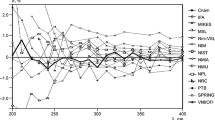Abstract
PHOTO-ELECTRIC polarimeters are not yet available commercially, although several types have been described in recent years1. Between about 4500 and 6500 A. there is no particular advantage in using such instruments, since in this region visual spectro-polarimeters are very accurate and convenient; but for longer and shorter wave-lengths, photo-electric methods are less tedious than the older photographic ones. We are interested in the red and near infra-red for the extension of studies on the Cotton effect for blue nitroso compounds2, and we set out to adapt a Unicam spectrophotometer for measuring rotatory dispersion by adding two Glazebrook prisms and a graduated circle. The arrangement has proved to be so satisfactory for our work that we feel justified in making this preliminary communication.
Similar content being viewed by others
References
See Weissaberger, “Physical Methods of Organic Chemistry”, 2, 967 (New York, 1946).
Mitchell, J. Chem. Soc., 3258 (1928) and subsequent papers.
Kenyon and Dickes, Nature, 117, 304 (1926).
Author information
Authors and Affiliations
Rights and permissions
About this article
Cite this article
MITCHELL, S., VEITCH, J. Rotatory Dispersion Measurements with a Unicam Spectrophotometer. Nature 168, 662–663 (1951). https://doi.org/10.1038/168662a0
Issue Date:
DOI: https://doi.org/10.1038/168662a0
- Springer Nature Limited
This article is cited by
-
Structure Elucidation of Fungal Sespendole, an Inhibitor of Lipid Droplet Synthesis in Macrophages
The Journal of Antibiotics (2006)





